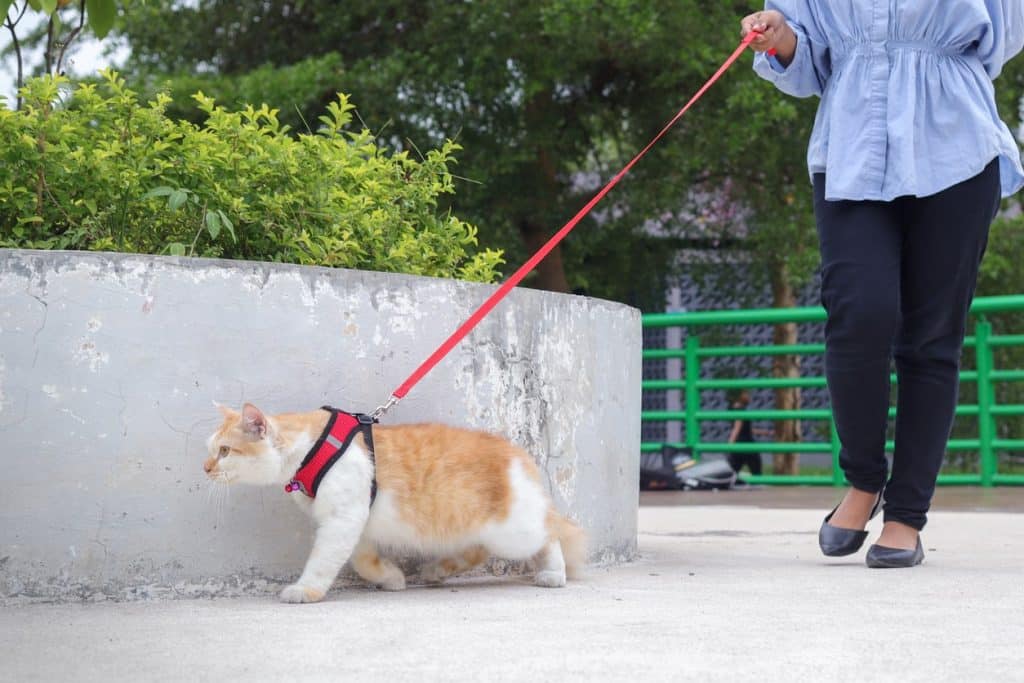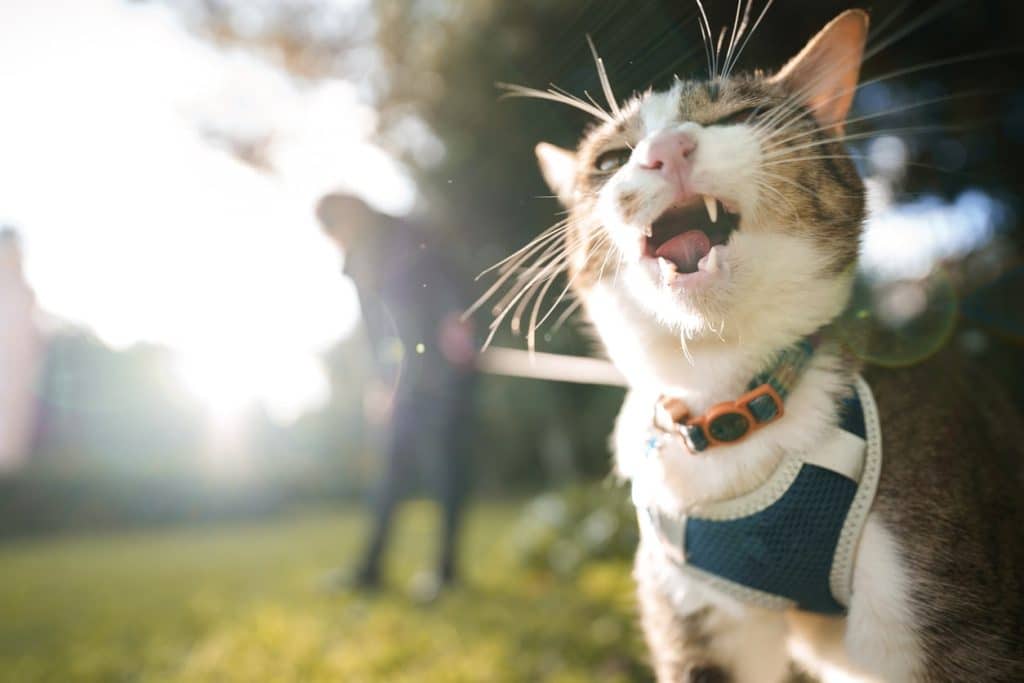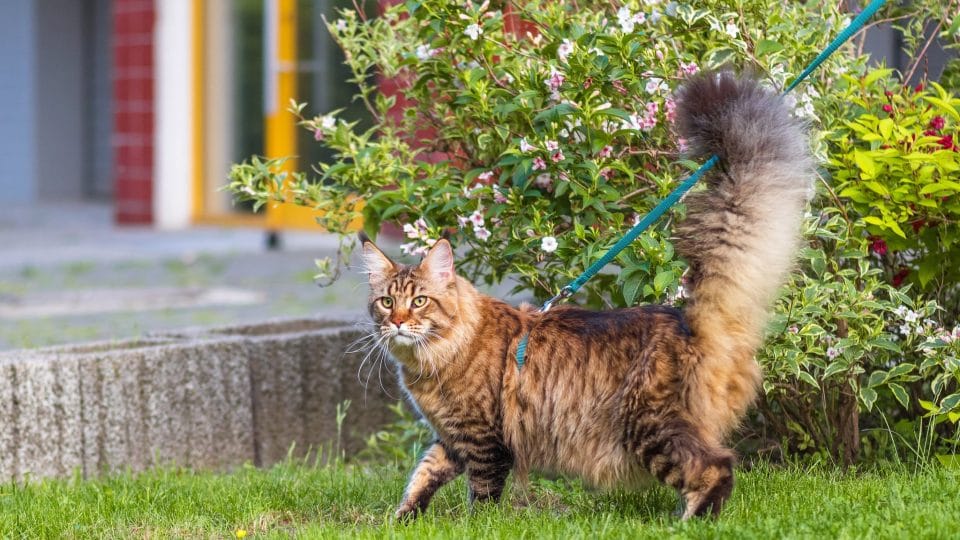Forget the myth of the lazy housecat! If you ever spot a dog walking blissfully alongside their human and wish you could walk your cat, you can! Lead training can be a great way to bond with your indoor cat and provide them with much-needed enrichment. Generally, the steps to lead train a cat include:
- Familiarising them with a harness
- Connecting the lead to the harness
- Purchasing a cat backpack they’ll enjoy
- Transitioning to outdoor walks
Like dogs, cats need daily mental and physical stimulation, and without enough of it, they can become bored, overweight, or even destructive.
We spoke to a few experts for lead training tips, including Dr Preston Turano, a veterinarian and spokesperson for Felix Cat Insurance. He says putting an indoor cat on a lead is more than okay: “It’s a great way to add some excitement and exercise to their daily routine.” Below, we detail the four steps for lead training cats and what you’ll need along the way.
Why Should I Walk My Cat?
While cats are content sunbathing, they’re also natural explorers who need to exercise their bodies and brains. Experts recommend that indoor cats get at least 30 minutes of daily exercise with their humans, yet surveys suggest that some pet parents think cats can manage their own activity and exercise.
The result? Overweight cats, frustrated pet parents, and shredded furniture. Here’s how walking your cat can help:
1. It’s good exercise
Obesity is the most preventable disease in cats, yet about 50% of cats are overweight or obese, making it the most common disease among cats. Studies say excess weight can decrease a cat’s expected lifespan by an average of two years, with indoor cats being most at risk of putting on the pounds. Exercise, such as outdoor walks, can help keep your kitty’s weight in check.
2. It provides mental stimulation
Routine walks can be a great way to break up the monotony of life as an indoor cat. Mary Molloy, an animal behaviour counsellor and founder of Nirvana Tails, agrees. “Going for walks outside can be incredible mental and physical enrichment for indoor-only cats,” she says. Molloy adds that indoor cats tend to get bored easily because they’re not hunting for food or exploring places of interest.
3. It strengthens the human/pet bond
Taking your cat for a walk is an excellent way to promote a healthy and happy relationship between the two of you. “Once trust and communication have been established, hiking with a cat and walking them on a lead becomes easier,” shares Albert Colominas, an adventure cat dad and founder of Outdoor Bengal. “You, as the cat guardian, become their safe space.”
This improved trust and communication extends beyond walks. Walking together improves your understanding of one another, a surefire way to make you their favourite person.
4. It’s safer than letting cats free-roam
While allowing your cat to come and go as they please—as many cats do in the UK— can be tempting, free-roaming the outdoors comes with risks like traffic, fights with other animals, and exposure to diseases. Lead training isn’t the only solution for exercise, but it provides a safe way for adventurous cats to experience the outdoors with you.
What Do I Need For Lead Training?
To successfully walk a cat, you’ll need more than a lead and a collar. In fact, Dr Turano says to never connect a lead to a cat’s collar. Collars can put strain on a cat’s neck and can easily slip off. Here’s a cat-walking supply list to get you started:
- Harness. The best cat harness is comfortable, escape-proof, and fits snugly without restricting movement. Make sure you properly fit your cat with a harness and train them to feel comfortable. This is vital before starting official lead training.
- Lead. Choose a cat lead length that allows your cat some freedom while keeping them safe. A wrist strap attachment is recommended for added security.
- Collar and ID tag. Ensure your cat wears a collar with an up-to-date ID tag at all times. However, never attach the lead to the collar.
- High-reward treats. Cat training treats reinforce good behaviour during lead training.
- Cat backpack. Provides a safe haven for your cat during your walk and in the car.
- First-aid kit. Include the basics for minor injuries.
- Towel. This can make scooping up a scared or injured cat easier and safer.
- Vaccinations. Ensure your cat has all the vaccinations they need for safe outdoor exploration in your area. Talk to your veterinarian for specific recommendations.

iStock/Yazid Nasuha
Cat Lead Training: Step-By-Step Guide
Cats are more open to learning new things when rewards are at stake. Don’t worry if it takes days or even weeks to move on from step one; sometimes, going back one or two steps to relearn something that got fuzzy is essential.
Familiarise your cat with their harness
Help your cat feel comfortable around their harness before putting it on them. To do this, place the harness on the floor and allow your cat to explore it at their own pace. Reward them with treats or praise as they approach it and interact with it, like sniffing it.
Next, pet your cat, placing the harness against their fur rather than your hand. If the harness makes any sounds (like a snap or Velcro), make the noise and immediately reward your cat with a treat or praise. Repeat this process until your cat shows no negative reaction to the sounds or touch of the harness.
Finally, it’s time to put the harness on your cat, but we’re not going outside just yet! Start with short periods of your cat wearing the harness indoors, gradually increasing the duration.
Pro tip: don’t be surprised if your cat freezes or flops over at first. Use a positive tone to show them it’s not scary and encourage them to approach you with a tasty treat. Keep encouraging your cat to do fun things while wearing their harness, like play or eat a meal.
Connect the lead to the harness
Repeat the above steps using the lead, including desensitising your cat to the sight, sounds, and feel. Once your cat shows no negative reactions, attach the lead to their harness while staying indoors. As with introductions to their harness, keep sessions short at first, building up to more time and more fun activities.
Pro tip: encourage your cats to explore while wearing the harness and lead for this step. For example, let them into a room they’re not normally allowed in (a closed-off portion of a basement, for example). Alternatively, keep your cat in a familiar space and scatter treats for them to find, encouraging them to walk around the house wearing their lead and harness.
Purchase a cat-friendly backpack
For your cat’s backpack, follow the same steps you used for the harness and lead. By leaving the backpack out at all times, your cat might find that it’s a safe, cosy place to nap. Encourage them to jump into their backpack with the help of clicker training and/or treats.
Have all that down? If so, it’s time to pick up the backpack with your cat inside and walk around the house.
Pro tip: if you plan to drive to walking spots with your cat, now is a good time to desensitise them to the car and car rides:
- Walk to the car. Carry your cat in their backpack to the car.
- Sit in the stationary car. Place your cat in a parked car, secured in their backpack. Turn on the engine for short periods, gradually increasing the duration.
- Go for a short drive. Once comfortable with the parked car, take your cat for short drives in their backpack.
Take lead-training outdoors
All that work you and your cat have done indoors is about to pay off! For your first walk with your cat outside, avoid busy parks, streets with traffic, or wide-open spaces that might feel overwhelming. Your balcony, porch, or a quiet corner of your garden are all great first-walk choices.
Keep the first few walks brief and positive. Dr Turano says once your cat feels safe outside, you can gradually increase the walking distance. Importantly, let your cat decide the pace and direction of exploration. This might mean not going very far, but it will help them feel in control, which cats love.
Pro tip: discourage door dashing by teaching your cat to sit at a designated spot before clipping on the lead. Rather than allowing your cat to walk over the threshold of the door themselves, pick your cat up and set them outside or place them in their backpack to take them outside.
Do Some Cats Like Lead Training More Than Others?
Cats of all ages can learn how to walk on a lead and harness, but Dr Turano says their success depends on their personality and your approach. Some cat breeds are known for being more outgoing, curious, or water-loving than others, which may make them more accepting of lead training. Examples of lead-training breeds include:
- Bengal Cats
- Savannah Cats
- Norwegian Forest Cats
- Maine Coons
- American Bobtail
- Turkish Angora
- Turkish Van
Lead training can be a rewarding experience for many cats and their humans, but it’s not for everyone. Some cats will take to lead training quickly, while others may find the outdoors overwhelming and prefer the comfort of their familiar life indoors. Instead, offer plenty of other outlets for mental and physical exercise, such as:
- cat trees
- scratching posts
- interactive toys
- solo-play toys
- cosy beds
- an exercise wheel
- window perches

iStock/Capuski
6 Lead Training Troubleshooting Tips
Taking your cat for a walk is about enjoying the experience together, not necessarily reaching a destination. Remember, you are walking a cat, not a dog. Here’s how to make walks together go smoothly:
- Be patient. Revisit training steps if needed and reward positive experiences.
- Create a routine. Familiar routes and routines can help your cat know what to expect.
- Respect your cat’s limits. Don’t force your cat to walk when they don’t want to or farther than they’d like. “As far as distance, start with something short and easy,” Molloy says. “Just like any other kind of exercise, you want to build duration gradually.”
- Offer a backpack. Offer a lift when your cat needs a break, feels overstimulated, or gets spooked.
- Reward success. Use treats and praise to keep your cat motivated.
- Choose the right weather. Opt to walk on days with ideal weather.
You don’t have to wait for something to go wrong to seek professional help. A veterinarian or cat behaviourist can assess your cat’s temperament and provide personalised training plans that can be used on and off the trail.
If your cat spends a lot of time hiding or is scared of things in their environment, they may need help to overcome fears before walking on a lead.
Walking your cat on a lead can be a rewarding activity—one that you can both enjoy. Keep training sessions short and positive, and you will see progress. Just have realistic expectations, and remember, lead walking isn’t for every cat.



